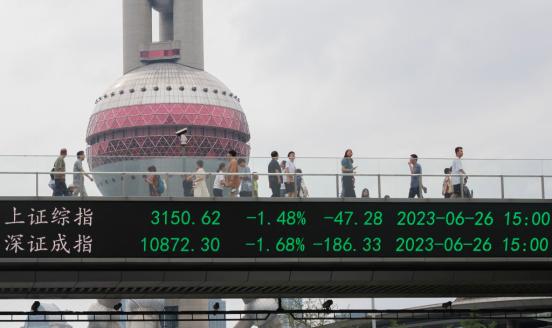Expect a U-shape for China’s current account
As the US aims to reduce it's bilateral trade deficit, China's current-account surplus is back in the headlines. However, in reality China’s current-a
China’s current-account surplus is back in the spotlight amid the US quest to reduce its bilateral trade deficit with the Asian country. However, the reality is that China’s current-account surplus has dropped significantly from its peak during the 2007-08 global financial crisis.
From China’s perspective, a narrower current-account balance may be helpful as it could ease the concerns of the rest of the world about China’s export machine. But it also has disadvantages, namely reducing China’s ability to respond to unexpected shocks, as the accumulation of foreign-exchange reserves from a trade surplus would in principle stop, if not retract. While most Western economists would argue that China’s external buffer, namely Forex reserves, are excessive, this might not be the view of China’s leadership, especially after the recent experiences with US-led disruptions and other types of tail risks.
Over and above the ongoing reduction of China’s current-account surplus, the US push for China to reduce its bilateral trade surplus puts even more weight on the – by now consensus – view that China’s current-account surplus is an issue of the past and that we should expect a structural deficit down the road.
This prediction might not come true, however. The most obvious reason, at least in the short term, is the breakdown of trade negotiations between the US and China, but this is not the whole story. There are other important reasons, related to the very nature of China’s reduced current-account surplus, that lead us to expect a reversal of the current trend, back toward a renewed surplus.
There are other important reasons, related to the very nature of China’s reduced current-account surplus, that lead us to expect a reversal of the current trend, back toward a renewed surplus.
In fact, trade in goods contributed to less than one-third of the shrinking current-account surplus, with services (especially tourism) explaining the rest. The rising tourism deficit appears to be easily explained by the large number of Chinese tourists overseas, but that too is not the full story. A comparison of China’s reported tourism deficit with its key trading partners’ reported tourism trade surplus shows that the former is significantly bigger than the latter, reflecting the reality that China’s reported tourism expenditure is not actually fully on the usual tourism-related means but actually has other objectives.
In fact, a large bulk of the deficit might be outright capital flight to circumvent capital-account restrictions. As such, measures to clamp down on tourism expenditure could eventually be taken if China did not manage to attract enough capital to counter the reduction in the current-account balance. This is especially so under the current managed exchange-rate mechanism, which requires enough Forex reserves to buffer RMB depreciation pressure. In other words, tourism is an obvious source of unrecorded capital outflows – equivalent to more than half of the goods trade surplus – and may be restricted to push up the current-account surplus.
From a long-term domestic perspective, a high savings rate is the key for China to keep its current account in surplus. But in recent years, China’s domestic savings rate has been on a downward trajectory. Corporate saving has slowed because of the leverage binge that Chinese companies have experienced since the massive stimulus Beijing has carried out since the global financial crisis. More recently, slower household income growth, the transformation toward a consumption-driven growth model and the strengthened social-security system have contributed to a decline in household savings as well. Finally, the decline in China’s government savings is due to the slower growth in fiscal revenues and the frequent need to stimulate the economy on the back of increasingly lower potential growth.
Down the road, all of the above structural factors are to remain, which should in principle push the current account toward a deficit. This consensus view, though, assumes that investment will remain high in China, and this is where we tend to disagree. In fact, investment has remained high artificially as a consequence of consecutive stimulus plans.
Public investment has played an important buffering role every time private investment decelerated because of the worsening economic outlook. This has again been the case since the beginning of 2019, which explains the correction in the current-account surplus toward a deficit but, structurally, investment in China can only go down as the return on assets continues to fall. In other words, expect a smaller – if not negative – current-account balance in 2019, but not later, as investment cannot be maintained artificially high for ever.
The clampdown on tourism expenditure may be the trigger to turn the current-account deficit back to positive, which can only reflect a lower investment ratio down the road, even lower than the reduction in the savings ratio. This, of course, does not bode well for China’s potential but it does explain why China’s widely expected current-account deficit might be short-lived. It might, thus, be wiser to expect a U-shaped current-account balance for China down the road. The US negotiators dealing with China now might not like this, though.




